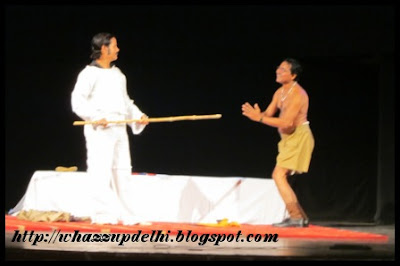The Akshardham Temple has been designed to epitomise 10,000years of Indian Culture. This 100 acre sprawling facility was constucted in 5 years with 11,000 artisans and volunteers.
The Akshardham temple is quite serious about security, so if you plan to visit, do note that the only things you are allowed to carry inside other than the clothes you are wearing (cap/shawl/sweater, reading glasses, cooling glasses/shoes are all ok - knees need to be covered) the only things you CAN carry with you are your wallet (not purse) and house/vehicle keys. No food items, no mobile phones, no flowers, pen, paper etc. Leave all these behind in your vehicle and you will be able to avoid the queue to deposit and retrieve these "non-permitted items" at the cloakroom.
The temple sees 1000's of visitors daily, so the more queues you can avoid, the smoother your experience will be. Especially given how a majority of my country men and women seem incapable of understanding the concept of a queue.
When I visited the temple in Summer the visitors were minimal. In the peak of winter, we returned from the gate twice, just because the crowds assembled outside did not seem like the effort was worth it. This Tuesday, we shared the entry queue with at least 6000 school children who were visiting on school tours. The trust does its best to make queues move smoothly, but the sheer numbers involved can make entry very frustrating.We witnessed at least 2 people having long drawn out arguments with the body pat-down checkers "Why can't I take my phone with me? It will take too long for me to go back and deposit it at the cloak room or the vehicle"
There is a queue to enter the security queue. This first queue is to manage the crowd before they reach the security queuing area. If you have something to leave behind in the cloak room, then get into that queue before you come to this.
There are 2 physical pat downs following the security queue which are very thorough. But once you get past this, then things get much better.
Someone mentioned that you can bring in one transparent clear bottle of water. But there are enough free taps and Coke's Bon Aqua (15Rs for a liter) on sale to just ignore the hassle of carrying a bottle through security.
You enter past the 10 Gates and the Bhakti Dwar- decorated with 208 sculpted forms of God and his devotee - into a large and comfortable room. If you would like to pick up a basic guide to what you are going to see - brochures are available in multiple Indian and foreign languages for 5Rs.
On the other side of this building are 2 beautiful Mayur(peacock)Dwars with 869 scultped peacocks each. Between these 2 dwars is a little pond which bear the resemblance of the Holy footprints of Bhagwan Swaminarayan with its 16 chinh (sacred signs of God).
Turn left towards the Bharat Upvan - 22 acres of sculpted gardens with bronze statues of Child heroes of India, Patriots of India and Great Men & Women of India. The Sun Chariot and moon chariot are supposed to be the most beautiful, but seem to be missing for the last few months.The garden itself is very tranquil and a wonderful place for quiet contemplation.
Walk back towards the Mayur Dwar and on the left you will see a ticket counter for the 3 shows in the complex. If you want to see any of them, you need to buy the combined ticket which is 170 for adults, 125 for senior citizens and 100 for children.
As you start to walk towards the 3 exhibitions, you will come across a photographer who will take a picture for you with the temple in the background and provide you with an 8*12 print after half an hour for 130Rs (upto 6 people in a photogrpah). There is another photographer at the diagonal opposite behind the mandir, but I prefer this front view of the mandir.
Then proceed to view the shows. You will have to queue up outside each venue in turn.There are refreshment stands and washrooms at entry and exit of each of these exhibitions
I would personally recommend skipping the first show - the Sahajanand Darshan/ Hall of Values - the Animatronic show. The story is covered better in the film show. My experience of the ANimatornic show in the middle of Summer with minimal crowds was bad enough, that I wouldn't even suggest it during peak times. The problem is that the 50 minute show is spread across at least 20 different rooms with an entry and exit. And the majority of the people in the group will be pushing, prodding and pulling to be the first to leave, get the BEST seats etc etc. Its not worth the hassle, ensuing irritation and physical pain of being trod on by clods.
The Neelkanth Darshan is a 40 minute film on an IMAX screen. This is a beautiful, well shot film on the life and travels (12,000km in 7 years on foot) of 11 year old child yogi Neelkanth Varni who later came to be known as Bhagwan Swaminarayan. If you have no idea about the person to whom this complex is dedicated - the movie is a must watch. It also has some stunnign cinematography.
Sanskruthi Vihar is a 15 minute boat ride through 10,000 years of Indian culture and 800 lifelike statues on the banks of the Saraswati.
As you walk out from here, you will cross the Yagnapurush Kund. In the evening (post sunset) there is a 15 minute Musical Fountain show here, based on the Holy Trinity of Brahma, Vishnu and Mahadev (Shiv), their roles and respective musical isntruments. The show costs 30Rs and tickets can be bought at the counter bordering the shoe deposit counter.
The Mandir itself is surrounded by the Narayan Sarovar on 3 sides. The Holy waters of 151 rivers, lakes and baolis (stepwells) visited by Neelkanth Varni have been ritually added to this Narayan Sarovar fringed by 108 gaumukhs. As you walk along the 2 storeyed Parikrama - colonnade bordering the Sarovar, you will come across the Abhishek Mandapam where you can ritually pour a water offerring on the murti of Neelkanth Varni.
After the Parikrama, Narayan Sarovar and Gaumukhs, you can then come inside to the next concentric walkway which is the exterior of the temple. The Gajendra Peeth is 1070 feet long along the exterior of the Mandir. It features 148 sculpted elephants in the themes of Elephants and Nature, Elephants and Man and Elephants and the Divine.
Before entering inside the main Mandir, you will have to leave your shoes outside at one of the 2 large counters designated for this purpose.The Mandir is stunningly beautiful and as well carved and intricate as the rest of this building complex. It is so beautiful and has so much detail that one can spend hours just lost in the intricacies of each element. Look up at the beautiful domes and samvarans (quadrangle pinnacles) In the centre of this mandir is the 11foot gold plated murti of Bhagwan Swaminrayan. The consecrated Gods inside this mandir are Shri Radha-Krishna, Shri Sita-Ram, Shri Lakshmi-Narayan and Shri Parvati-Shiv.
When you have absorbed as much as is humanly possible, step out and take a seat and let it all sink in. Once you collect your shoes, do remember to collect your photograph if you have got one clicked.
Head left outside the mandir and cross the Yogihriday Kamal - 8 petal lotus shaped garden and you will arrive at the Premvati Food Court (detailed review on my restaurant review blog). The food is definitely worth trying.
Since you can't take any pictures you may want to consider buying the 50Rs photographic souvenir of Akshardham at the Souvenir Shop. There are also pooja sets, agarbattis, religious books, ayurvedic medicines and other such items on sale at very reasonable prices.
Once you have picked up your souvenirs, you are done, but you may not be ready to leave the tranquility of Akshardham and re-enter the real world traffic of the Delhi-Noida crossing.
Timings:
April to September 10am - 7pm
October to March 9am-6pm
Monday Holiday
There is ample Parking Space. Parking fee is about 20Rs for a car.
Please Note: Photogrpahy is not permitted inside Akshardham - the picture used here is from http://www.akshardham.com Please click on the links above for more pictures.



































